
|
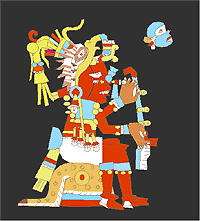
Archaeology of Ambergris Caye
Late Preclassic and Early Classic Periods
The first known occupation of Ambergris Caye occurred during the Late
Preclassic period (300 B.C. - 300 A.D.) and is evidenced from the sites
of Chac Balam and Marco Gonzales. Unfortunately, the evidence for Late Preclassic
occupation is quite meager. A single mammiform sherd was found in the surface
collection from Chac Balam and no construction or intact occupation has
been located. Similarly, Graham and Pendergast (1989) found a few Late Preclassic
sherds underlying the major construction at Marco Gonzales.
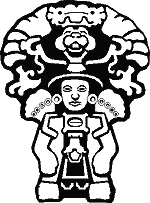 It was during this time, though, that Cerros flourished as a trade center
at the mouth of the New River in Corozal Bay (Robertson and Freidel 1986;
Garber 1989). It is likely therefore, that the Bacalar Chico, if it existed,
was used for canoe traffic and linked Cerros with at least the northern
coast. It was during this time, though, that Cerros flourished as a trade center
at the mouth of the New River in Corozal Bay (Robertson and Freidel 1986;
Garber 1989). It is likely therefore, that the Bacalar Chico, if it existed,
was used for canoe traffic and linked Cerros with at least the northern
coast.
Early Classic materials have also been found only at two sites; Laguna
de Cayo Frances and Yalamha. A third-party collection from Laguna de Cayo
Frances included a few Early Classic sherds, but no other Early Classic
materials were discovered during subsequent visits to the site, despite
considerable deep exposure due to looters. Yalamha, which translates from
Mopan Maya, literally, as "place under water," appears to have
been a small residential site on the leeward side. Rising sea level, and
presumably, related wave erosion have deflated the site, and all that remains
is a scatter of artifacts under about a meter of water.
Consequently, little more is known of the Early Classic than of the Late
Preclassic. However, it is clear the permanent occupation of the island
occurred by the Early Classic.
Late Classic Period
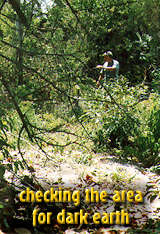
During the Late Classic period significantly more activity occurred on
Ambergris. Late Classic components are known from nearly all sites. The
primary information, though, comes from excavations at San Juan, Chac Balam,
and Ek Luum. At about 600 A.D. construction of formal architecture was under
way at these and several other sites, and the general site plans as they
appear in the Terminal Classic period were being developed. The general
settlement pattern of the island shows intensive occupation of the coastline
with little occupation of the interior.
By this time, San Juan and Chac Balam had access to the open Caribbean
through the Bacalar Chico and its feeder canals. So did other sites on the
leeward side and on the interior lagoons: Burning Water, Santa Cruz, Punta
Limón, Laguna de Cayo Francesa, and Ek Luum.
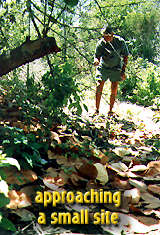
Trade was a major consideration in the development of these communities.
Each was located with respect to a natural harbor or an artificial harbor
was constructed. Each had formal architecture and several- Chac Balam, Marco
Gonzales, Santa Cruz, Laguna de Cayo Francesa and Burning Water- had formal
plazas. Excavations at Chac Balam and San Juan indicate that these sites
had a considerably higher level of access to exotic goods that sites on the
westward side, which lacked formal architecture and harbor facilities. Also,
Str. 3 at San Juan exhibit strong architectural affinities to northern Yucatan.
The extent of the Late Classic period occupation at Marco Gonzalez is
not clear at this point in time. However, marine resource exploitation and
salt-working activities have been reported (Graham and Pendergast 1989)
It is reasonable to assume that several of the mound constructions have
a significant Late Classic component and participated in the maritime trade
system in much the same way as the sites on the northern end of the island.
These larger, more affluent sites apparently represent the activities
of family enterprises in the coastal trade system. Though the scale of the
sites is variable, there is no evidence to support a proposition of any
centralized authority on the island. The political relationships with mainland
sites such as Santa Rita, though, cannot be adequately assessed.
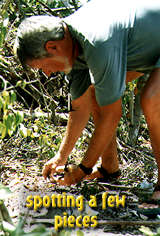
Many smaller residential sites were present at this time. Examples include
Guerrero, Franco, and Valencia. These have crude ceramics which were probably
made on-site, few or no exotic goods, burials with few or no grave goods,
and only simple plastered house floors. These small sites apparently were
simple fishing villages. The leeward sites, on the other hand, were economically
based on trade with easy access to maritime resources.
During the Late Classic and subsequent Terminal Classic periods, a number
of inter-relationships can be seen. While ceramics from the Northern Belize
sphere dominate the assemblages at San Juan, Chac Balam, and Ek Luum, materials
from a number of other areas are included. The Belize Valley, southern Belize,
Campeche, and Yucatan all contribute to these assemblages. This would appear
to be a function of Ambergris participation in a trade system that incorporated
all of these areas. The obsidian also reinforces this interpretation. Most
obsidian came from the Guatemalan highlands and was probably shipped down
the Motagua River and northward along the coast. At San Juan, however, there
was a high percentage of Pachuca green obsidian, which would have been transported
by boat around northern Yucatan. No sources of chert for chipped stone tools
are known to exist on Ambergris. Therefore, all such materials also had
to be imported, many as finished tools. These tools were then reworked as
necessary by the Ambergris population. This population, understandably,
was not very skilled at stone knapping.
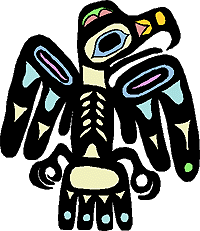
A dichotomy of settlement also existed at this time. Wealthier communities
which participated in the trade system were on the western or leeward side
of the island, and, in the case of Burning Water, the northern interior
lagoons. All of these communities had very high access to exotic goods.
The calm waters of the leeward side and natural coves provided strategically
useful locations for such settlement. Where such natural harbors did not
exist, such as the apparent case of Chac Balam where the harbors seem to
be man-made. Burning Water and, in a sense, Ek Luum, were linked to the
other communities and the trade routes by open channels which were possibly
man made. They were also located so that they could easily be reached by
canoes coming from the coast bringing goods to be later loaded onto canoes
plying the coast itself.
On the windward side of the island, communities did not have access to
exotic goods to the degree of their wealthier neighbors. They made their
own pottery, had fewer stone tools, and erected no buildings with substructures,
or formal architecture. The reef merges with the island at Rocky Point,
cutting off these communities from the long-distance trade routes.
Terminal Classic Period

Changes leading to the Terminal Classic seemed to have been quantitative
rather than qualitative. Most sites show a continuation of the patterns which
had been developed earlier. Major construction at these sites, however,
was replaced by repeated reburbishings on a smaller scale. Trade goods were
abundant and interaction is seen with Yucatan, Campeche, and southern Belize
as well as mainland northern Belize. A mortuary pattern of repeated, very
shallow burials reflects the low level of energy invested in all such activities.
During this period Ambergris continued to participate in the maritime trade
system. However, we do not know what stresses were exerted upon the system which
reduced construction activity.
At the end of the Terminal Classic period, though, major changes occurred
on Ambergris. With the exception of Marco Gonzalez, nearly all sites on
the coast were abandoned, and, as a result, trade activities on Ambergris
were limited to, or more correctly, consolidated at Marco Gonzalez. At San
Juan, small buildings were constructed on the flanks of the site at the end
of this period. The most recent radiocarbon date of approximately 1000 A.D.
comes from this context and nearly marks the abandonment of the site. While
some activity continues at Chac Balam after 1000 A.D., it is probable that
the site was no longer fully occupied and may have been used primarily for
mortuary purposes
Postclassic Period
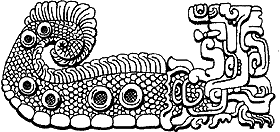
The data from the Postclassic period reflect a major restructuring of
both settlement on Ambergris Caye and the economic system of the Maya. The
small, coastal margin communities were abandoned and activity was consolidated
at the Marco Gonzalez site and, perhaps, the Basil Jones site.
At Marco Gonzalez, Graham and Pendergast (1987, 1989) found continuous
occupation from the Late Classic into the Postclassic. Importantly, continued
major construction occurred in the Postclassic at Marco Gonzalez. It is very
possible that the close ceramic affinities between Marco Gonzales and Lamanai
are associated with the community's apparent independence from the factors
that influenced the abandonment of the coastal margin of the northern part
of the island (Pendergast 1990).
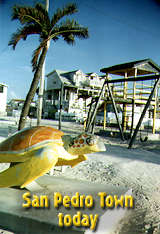
Basil Jones, in the interior of the island, and the San Pedro Lagoon
site are believed to be Postclassic. These assessments are based upon the
presence of the very crude stone buildings and, in the case of Basil Jones,
the field walls. Also, the elaborate Postclassic burial excavated by Thomas
Gann on Ambergris, at 'the largest mound,''was probably at Basil Jones.
We initially believed this site to be San Juan but we presently think that
it was one of the now nearly demolished mounds of Basil Jones. However, A.
Andrews has suggested that the Gann mound was at the San Pedro Lagoon site
(personal communication). Interestingly, an early Spanish map shows a settlement
in this general area of Ambergris which may well he Basil Jones (Grant Jones,
personal communication), so occupational continuity may have occurred.
The growth of Basil Jones, then, reflects an adaptation with a more terrestrial
focus. Even so, trade may have continued to be an important focus, and Basil
Jones could have functioned similarly to San Gervasio and Buena Vista on
Cozumel (Sabloff and Rathje 1975). Nevertheless, a complete structural shift
clearly occurred.
The only Middle Postclassic site found so far on Ambergris Caye is Los
Renegados. The very large quantities of obsidian recovered from the site
indicate that coastal trade was flourishing. However, its impact on the
island was much different than previously. Los Renegados includes no formal
architecture, only dense residential debris,and the floors of perishable
buildings. We cannot know if, at this time, Basil Jones or other sites were
occupied.However, Graham and Pendergast have found evidence of residential
and mortuary activity at the San Pedro site dating from this period.
The photos on this page are of archaeologist Dr. Herman Smith, in the Tres Cocos area. For his column on Archaeology in Belize, click here.
BELIZE and AMBERGRIS CAYE HISTORY LINKS
History Home
|
Ambergris Caye History- In Depth |
Ambergris Museum
|
Maya History
|
Early History of Belize, Glyphs, Timeline
|
150th Anniversary of San Pedro Town
|
Field Guide to Ambergris Caye
|
Angel Nuñez' column "25 Years Ago on Ambergris Caye"
|
Herman Smith's column on Archaeology in Belize
|
Maya History of the island
|
Marco Gonzales
|
Maya Sites in Belize
|
Alternative Medicine in Belize
|
Aztec Account of Spanish Conquest
|
Excavations on Ambergris Caye
 Print Print  PDF PDF
 Email Email
|